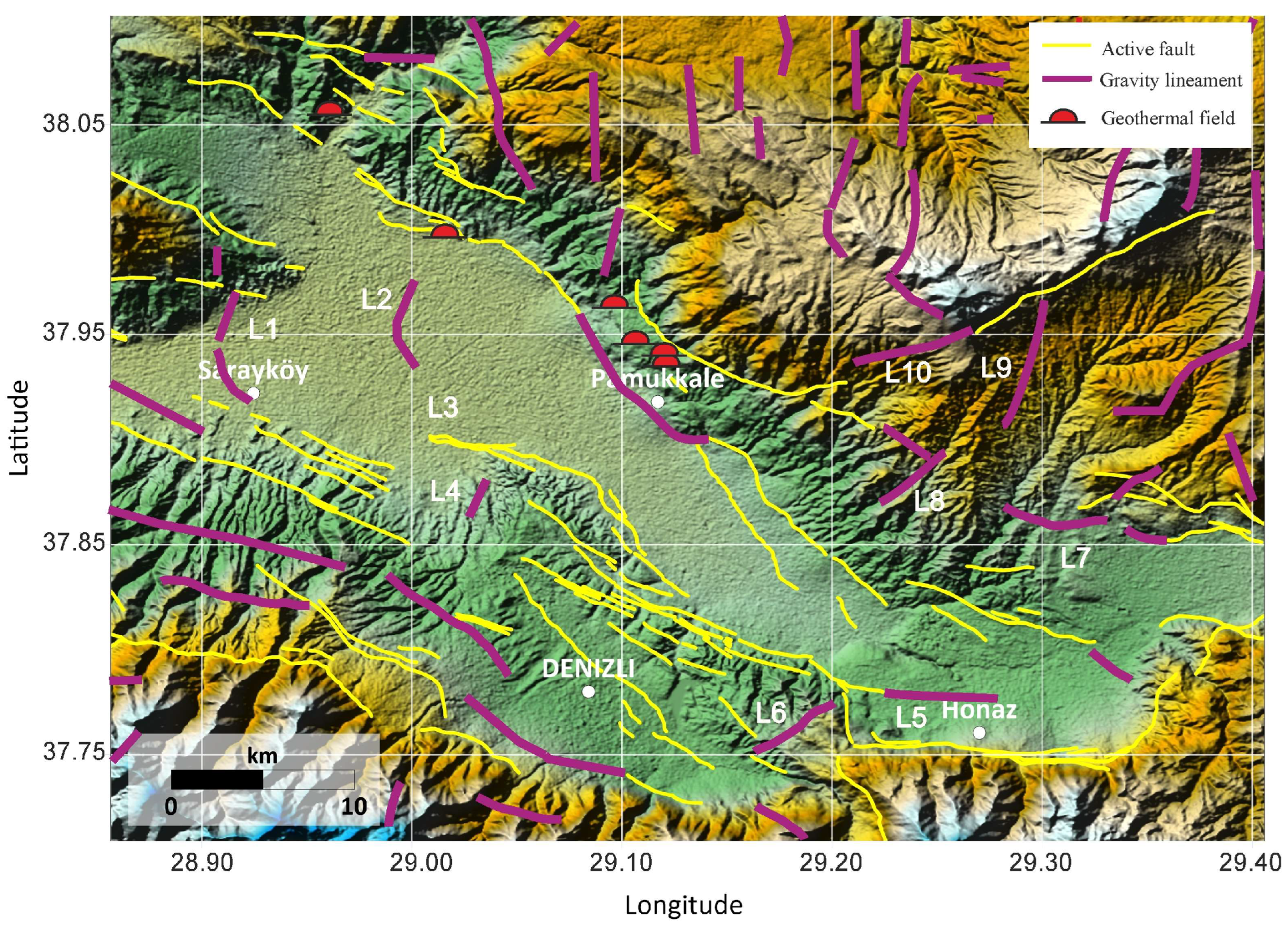Mapping of the Structural Lineaments and Sedimentary Basement Relief Using Gravity Data to Guide Mineral Exploration in the Denizli Basin
Abstract
:1. Introduction
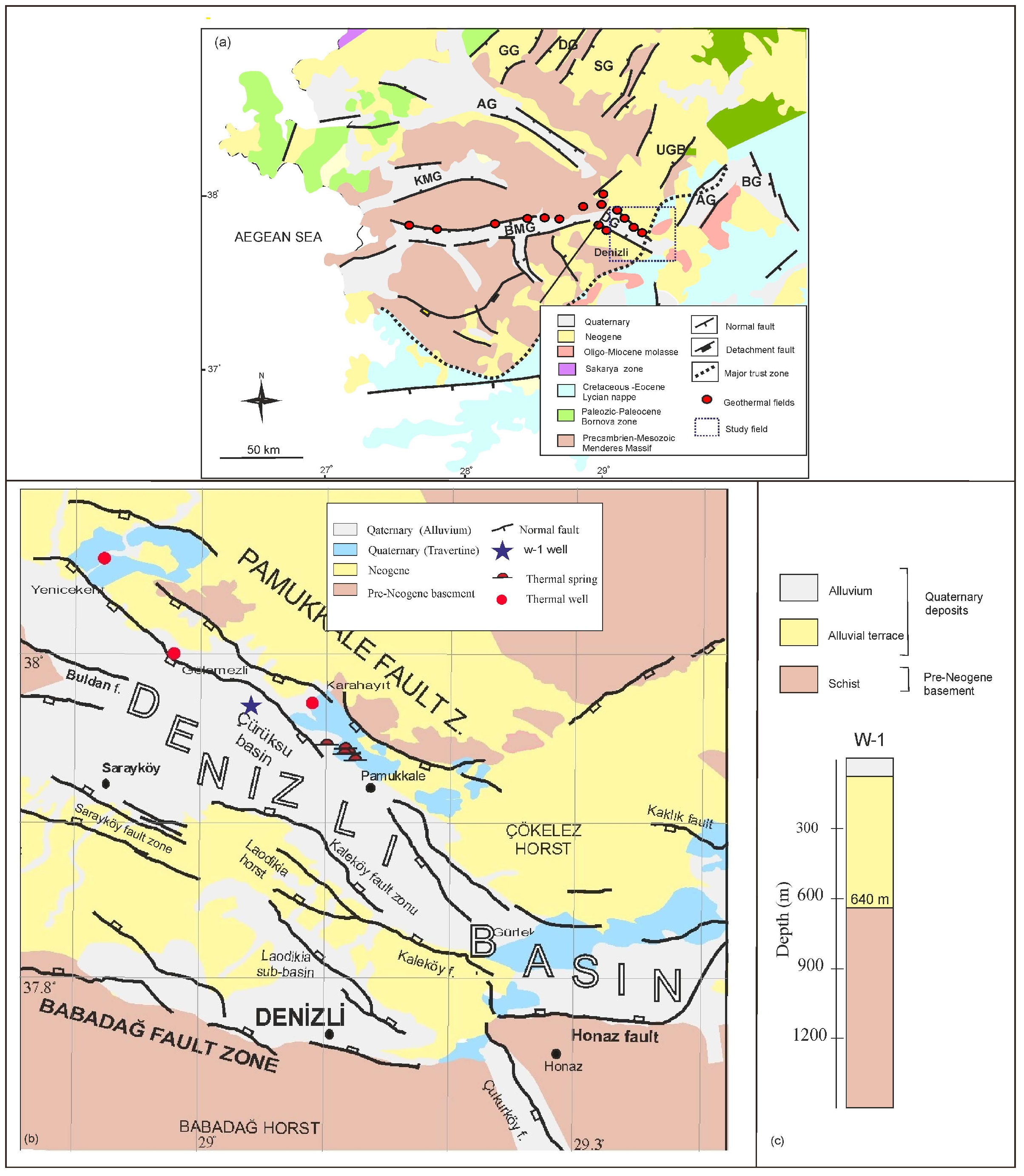
2. Tectonic Settings of Denizli Basin
3. Data and Methods
3.1. Basin Depth Model
3.2. Detection of Lineaments
4. Results
4.1. Sedimentary Basin Depth Model
4.2. Lineament Detection
5. Conclusions
Funding
Data Availability Statement
Conflicts of Interest
References
- Satyakumar, A.V.; Pandey, A.K.; Singh, A.P.; Tiwari, V.M. Delineation of structural and tectonic features in the Mahanadi basin, eastern India: New insights from remote sensing and land gravity data. J. Asian Earth Sci. 2022, 227, 105116. [Google Scholar] [CrossRef]
- Pham, L.T.; Oksum, E.; Kafadar, O.; Trinh, P.T.; Nguyen, D.V.; Vo, Q.T.; Le, S.T.; Do, T.D. Determination of subsurface lineaments in the Hoang Sa islands using enhanced methods of gravity total horizontal gradient. Vietnam J. Earth Sci. 2022, 44, 395–409. [Google Scholar]
- Alrefaee, H.; Soliman, M.; Merghelani, T. Interpretation of the subsurface tectonic setting of the Natrun Basin, north Western Desert, Egypt using Satellite Bouguer gravity and magnetic data. J. Afr. Earth Sci. 2022, 187, 104450. [Google Scholar] [CrossRef]
- Liu, J.; Li, S.; Jiang, S.; Wang, X.; Zhang, J. Tools for Edge Detection of Gravity Data: Comparison and Application to Tectonic Boundary Mapping in the Molucca Sea. Surv. Geophys. 2023, 1–30. [Google Scholar] [CrossRef]
- Kamto, P.G.; Oksum, E.; Pham, L.T.; Kamguia, J. Contribution of advanced edge detection filters for the structural mapping of the Douala Sedimentary Basin along the Gulf of Guinea. Vietnam. J. EARTH Sci. 2023. [Google Scholar] [CrossRef]
- Chakravarthi, V.; Shankar, G.B.K.; Muralidharan, D.; Harinarayana, T.; Sundararajan, N. An integrated geophysical approach for imaging subbasalt sedimentary basins: Case study of Jam River Basin, India. Geophysics 2007, 72, B141–B147. [Google Scholar] [CrossRef]
- Silva, J.B.; Oliveira, A.S.; Barbosa, V.C. Gravity inversion of 2D basement relief using entropic regularization. Geophysics 2010, 75, I29–I35. [Google Scholar] [CrossRef]
- Babu, H.R. Basement structure of the Cuddapah Basin from gravity anomalies. Tectonophysics 1993, 223, 411–422. [Google Scholar] [CrossRef]
- Blakely, R.J.; Christiansen, R.L.; Guffanti, M.; Wells, R.E.; Donnelly-Nolan, J.M.; Muffler, L.J.P.; Clynne, M.A.; Smith, J.G. Gravity anomalies, Quaternary vents, and Quaternary faults in the southern Cascade Range, Oregon and California: Implications for arc and backarc evolution. J. Geophys. Res. Solid Earth 1997, 102, 22513–22527. [Google Scholar] [CrossRef]
- Aydogan, D. Extraction of lineaments from gravity anomaly maps using the gradient calculation: Application to Central Anatolia. Earth Planets Space 2011, 63, 903–913. [Google Scholar] [CrossRef]
- Cherepanova, Y.; Artemieva, I.M.; Thybo, H.; Chemia, Z. Crustal structure of the Siberian craton and the West Siberian basin: An appraisal of existing seismic data. Tectonophysics 2013, 609, 154–183. [Google Scholar] [CrossRef]
- Anukwu, G.C.; Khalil, A.E.; Nawawi, M.; Younis, A.M. Delineation of shallow structures in the vicinity of Ulu Slim hot spring using seismic refraction and MASW techniques. NRIAG J. Astron. Geophys. 2020, 9, 7–15. [Google Scholar] [CrossRef]
- Salaun, N.; Toubiana, H.; Mitschler, J.-B.; Gigou, G.; Carriere, X.; Maurer, V.; Richard, A. High-resolution 3D seismic imaging and refined velocity model building improve the image of a deep geothermal reservoir in the Upper Rhine Graben. Geophysics 2020, 39, 857–863. [Google Scholar] [CrossRef]
- Jackson, J.A.; Mckenzie, D.P. The relationship between plate motions and seismic moment tensors and rates of active de-formation in the Mediterranean and Middle East. Geophys. J. Int. 1988, 93, 45–73. [Google Scholar] [CrossRef]
- Westaway, R. Neogene evolution of the Denizli region of western Turkey. J. Struct. Geol. 1993, 15, 37–53. [Google Scholar] [CrossRef]
- McKenzie, D. Active tectonics of the Alpine—Himalayan belt: The Aegean Sea and surrounding regions. Geophys. J. Int. 1978, 55, 217–254. [Google Scholar] [CrossRef]
- Şengör, A.M.C.; Yilmaz, Y. Tethyan evolution of Turkey: A plate tectonic approach. Tectonophysics 1981, 75, 181–241. [Google Scholar] [CrossRef]
- Bozkurt, E. Origin of NE-trending basins in western Turkey. Geodin. Acta 2003, 16, 61–81. [Google Scholar] [CrossRef]
- Kaymakçı, N. Kinematic development and paleostress analysis of the Denizli Basin (Western Turkish): Implications of spatial variation of relative paleostress magnitudes and orientations. J. Asian Earth Sci. 2006, 27, 207–222. [Google Scholar] [CrossRef]
- Jolivet, L.; Faccenna, C.; Huet, B.; Labrousse, L.; Le Pourhiet, L.; Lacombe, O.; Lecomte, E.; Burov, E.; Denèle, Y.; Brun, J.-P.; et al. Aegean tectonics: Strain localisation, slab tearing and trench retreat. Tectonophysics 2012, 597-598, 1–33. [Google Scholar] [CrossRef]
- Faccenna, C.; Becker, T.W.; Auer, L.; Billi, A.; Boschi, L.; Brun, J.P.; Capitanio, F.A.; Funiciello, F.; Horvàth, F.; Jolivet, L.; et al. Mantle dynamics in the Mediterranean. Rev. Geophys. 2014, 52, 283–332. [Google Scholar] [CrossRef]
- Dewey, J.F.; Şengör, A.M.C. Aegean and surrounding regions: Complex multiplate and continuum tectonics in a convergent zone. Geol. Soc. Am. Bull. 1979, 90, 84–92. [Google Scholar] [CrossRef]
- Bozkurt, E.; Mittwede, S.K. Introduction: Evolution of continental extensional tectonics of western Turkey. Geodin. Acta 2005, 18, 153–165. [Google Scholar] [CrossRef]
- Şengör, A.M.C.; Görür, N.; Şaroglu, F. Strike-slip faulting and related basin formation in zones of tectonic escape: Turkey as a case study. In Strike-slip Deformation, Basin Formation and Sedimentation; Biddle, K.T., Christie-Blick, N., Eds.; SEPM Society for Sedimentary Geology: Tulsa, OK, USA, 1985; Volume 37, pp. 227–264. [Google Scholar]
- Le Pichon, X.; Angelier, J. The hellenic arc and trench system: A key to the neotectonic evolution of the eastern mediterranean area. Tectonophysics 1979, 60, 1–42. [Google Scholar] [CrossRef]
- Le Pichon, X.; Angelier, J. The Aegean sea. Philos. Trans. R. Soc. Lond. 1981, 72, 300–357. [Google Scholar]
- Dewey, J.F. Extensional collapse of orogens. Tectonics 1988, 7, 1123–1139. [Google Scholar] [CrossRef]
- Seyitoglu, G.; Scott, B.C. Age of the Alasehir graben (west Turkey) and its tectonic implications. Geol. J. 1996, 31, 1–11. [Google Scholar] [CrossRef]
- Dilek, Y.; Whitney, D.L. Cenozoic crustal evolution in central Anatolia: Extension, magmatism, and landscape development. In Proceedings, Third International Conference on the Geology of the Eastern Mediterranean; Panayides, I., Xenophontos, C., Malpas, J., Eds.; Geological Survey Department: Nicosia, Cyprus, 2000; pp. 183–192. [Google Scholar]
- Koçyiğit, A.; Yusufoğlu, H.; Bozkurt, E. Evidence from the Gediz graben for episodic two-stage extension in western Turkey. J. Geol. Soc. 1999, 156, 605–616. [Google Scholar] [CrossRef]
- Sözbilir, H. Extensional tectonics and the geometry of related macroscopic structures: Field evidence from the Gediz de-tachment, western Turkey. Turk. J. Earth Sci. 2001, 10, 51–67. [Google Scholar]
- Koçyiğit, A. The Denizli graben-horst system and the eastern limit of western Anatolian continental extension: Basin fill, structure, deformational mode, throw amount and episodic evolutionary history, SW Turkey. Geodin. Acta 2005, 18, 167–208. [Google Scholar] [CrossRef]
- Gessner, K.; Gallardo, L.A.; Markwitz, V.; Ring, U.; Thomson, S.N. What caused the denudation of the Menderes Massif: Review of crustal evolution, lithosphere structure, and dynamic topography in southwest Turkey. Gondwana Res. 2013, 24, 243–274. [Google Scholar] [CrossRef]
- Yilmaz, M.; Gelisli, K. Stratigraphic–structural interpretation and hydrocarbon potential of the Alaşehir Graben, western Turkey. Pet. Geosci. 2003, 9, 277–282. [Google Scholar] [CrossRef]
- Çiftçi, N.B.; Temel, R.; Iztan, Y.H. Hydrocarbon occurrences in the western Anatolian (Aegean) grabens, Turkey: Is there a working petroleum system? AAPG Bull. 2010, 94, 1827–1857. [Google Scholar] [CrossRef]
- Altan, Z.; Ocakoğlu, N.; Böhm, G.; Sarıkavak, K.T. Seismic Events in The Upper Miocene–Pliocene Sed-Imentary Succession In The Gulf Of Izmir (Western Anatolia): Implications for Hydrocarbon Prospectivity. J. Pet. Geol. 2020, 43, 209–224. [Google Scholar] [CrossRef]
- Demircioğlu, D.; Ecevitoğlu, B.; Seyitoğlu, G. Evidence of a rolling hinge mechanism in the seismic records of the hydrocarbon-bearing Alaşehir graben, western Turkey. Pet. Geosci. 2010, 16, 155–160. [Google Scholar] [CrossRef]
- Tüfekçi, N.; Süzen, M.L.; Güleç, N. GIS based geothermal potential assessment: A case study from Western Anatolia, Turkey. Energy 2010, 35, 246–261. [Google Scholar] [CrossRef]
- Erkan, K. Geothermal investigations in western Anatolia using equilibrium temperatures from shallow boreholes. Solid Earth 2015, 6, 103–113. [Google Scholar] [CrossRef]
- Baba, A.; Sözbilir, H. Source of arsenic based on geological and hydrogeochemical properties of geothermal systems in Western Turkey. Chem. Geol. 2012, 334, 364–377. [Google Scholar] [CrossRef]
- Şimşek, Ş. Geothermal model of Denizli, Sarayköy-Buldan area. Geothermics 1985, 14, 393–417. [Google Scholar] [CrossRef]
- Özgür, N. Geochemical signature of the Kizildere geothermal field, western Anatolia, Turkey. Int. Geol. Rev. 2002, 44, 153–163. [Google Scholar] [CrossRef]
- De Filippis, L.; Faccenna, C.; Billi, A.; Anzalone, E.; Brilli, M.; Soligo, M.; Tuccimei, P. Plateau versus fissure ridge travertines from Quaternary geothermal springs of Italy and Turkey: Interactions and feedbacks between fluid discharge, paleoclimate, and tectonics. Earth Sci. Rev. 2013, 123, 35–52. [Google Scholar] [CrossRef]
- Brogi, A.; Alçiçek, M.C.; Yalçıner, C.; Capezzuoli, E.; Liotta, D.; Meccheri, M.; Rimondi, V.; Ruggieri, G.; Gandin, A.; Boschi, C.; et al. Hydrothermal fluids circulation and travertine deposition in an active tectonic setting: Insights from the Kamara geothermal area (western Anatolia, Turkey). Tectonophysics 2016, 680, 211–232. [Google Scholar] [CrossRef]
- Brogi, A.; Alçiçek, M.C.; Liotta, D.; Capezzuoli, E.; Zucchi, M.; Matera, P.F. Step-over fault zones controlling geothermal fluid-flow and travertine formation (Denizli Basin, Turkey). Geothermics 2020, 89, 101941. [Google Scholar] [CrossRef]
- Tarcan, G.; Özen, T.; Gemici, Ü.; Çolak, M.; Karamanderesi, İ.H. Geochemical assessment of mineral scaling in Kızıldere geothermal field, Turkey. Environ. Earth Sci. 2016, 75, 1317. [Google Scholar] [CrossRef]
- Karamanderesi, İ.H.; Ölçenoğlu, K. Geology of the Denizli Sarayköy (Gerali) Geothermal Field, Western Anatolia, Turkey. In Proceedings of the World Geothermal Congress, Antalya, Turkey, 24–29 April 2005. [Google Scholar]
- Mesci, B.L.; Tatar, O.; Piper, J.D.A.; Gürsoy, H.; Altunel, E.; Crowley, S. The efficacy of travertine as a palaeoenvironmental indicator: Palaeomagnetic study of neotectonic examples from Denizli, Turkey. Turk. J. Earth Sci. 2013, 22, 191–203. [Google Scholar] [CrossRef]
- Altunel, E.; Karabacak, V. Determination of horizontal extension from fissure-ridge travertines: A case study from the Denizli Basin, southwestern Turkey. Geodin. Acta 2005, 18, 333–342. [Google Scholar] [CrossRef]
- Çakır, Z. Along-strike discontinuity of active normal faults and its influence on Quaternary travertine deposition; examples from western Turkey. Turk. J. Earth Sci. 1999, 8, 67–80. [Google Scholar]
- Erees, F.S.; Aytas, S.; Sac, M.M.; Yener, G.; Salk, M. Radon concentrations in thermalwaters related to seismic events along faults in the Denizli Basin, Western Turkey. Radiat. Meas. 2007, 42, 80–86. [Google Scholar] [CrossRef]
- Van Noten, K.; Topal, S.; Baykara, M.O.; Özkul, M.; Claes, H.; Aratman, C.; Swennen, R. Pleistocene-Holocene tectonic reconstruction of the Ballık travertine (Denizli Graben, SW Turkey): (De) formation of large travertine geobodies at inter-secting grabens. J. Struct. Geol. 2019, 118, 114–134. [Google Scholar] [CrossRef]
- Ozkul, M.; Varol, B.; Alcicek, M.C. Depositional environments and petrography of Denizli travertines. Bull. Miner. Res. Explor. 2002, 125, 13–29. [Google Scholar]
- Hançer, M. Study of the structural evolution of the Babadağ-Honaz and Pamukkale fault zones and the related earthquake risk potential of the Buldan region in SW Anatolia, east of the Mediterranean. J. Earth Sci. 2013, 24, 397–409. [Google Scholar] [CrossRef]
- Seyïtoğlu, G.; Işik, V. Late Cenozoic Extensional Tectonics in Western Anatolia: Exhumation of the Menderes Core Complex and Formation of Related Basins. Bull. Miner. Res. Explor. 2015, 151, 47–106. [Google Scholar] [CrossRef]
- Sarı, C.; Şalk, M. Sediment thickness of the Western Anatolia graben structures determined by 2D and 3D analysis using graviy data. J. Asian Earth Sci. 2006, 26, 39–48. [Google Scholar] [CrossRef]
- Altinoğlu, F.F.; Sari, M.; Aydin, A. Detection of Lineaments in Denizli Basin of Western Anatolia Region Using Bouguer Gravity Data. Pure Appl. Geophys. 2015, 172, 415–425. [Google Scholar] [CrossRef]
- Altinoğlu, F.F. Structural interpretation of SW part of Denizli, Turkey, based on gravity data analysis. Arab. J. Geosci. 2020, 13, 1–16. [Google Scholar] [CrossRef]
- Ekinci, Y.L.; Balkaya, Ç.; Göktürkler, G.; Özyalın, Ş. Gravity data inversion for the basement relief delineation through global optimization: A case study from the Aegean Graben System, western Anatolia, Turkey. Geophys. J. Int. 2020, 224, 923–944. [Google Scholar] [CrossRef]
- Akkuş, I.; Akıllı, H.; Ceyhan, S.; Dilemre, A.; Tekin, Z. Inventory of Turkey Geothermal Sources, Inventory Series-201; MTA General Directorate of Mineral Research and Exploration Publications: Ankara, Turkey, 2005. [Google Scholar]
- Bilim, F. Investigation into the tectonic lineaments and thermal structure of Kutahya-Denizli region western Anatolia, from using aeromagnetic, gravity and seismological data. Phys. Earth Planet. Inter. 2007, 165, 135–146. [Google Scholar] [CrossRef]
- Kaypak, B.; Gökkaya, G. 3D imaging of the upper crust beneath the Denizli geothermal region by local earthquake tomog-raphy, western Turkey. J. Volcanol. Geotherm. Res. 2012, 211–212, 47–60. [Google Scholar] [CrossRef]
- Irmak, T.S. Focal mechanisms of small-moderate earthquakes in Denizli Graben (SW Turkey). Earth Planets Space 2013, 65, 943–955. [Google Scholar] [CrossRef]
- Erbek-Kiran, E.; Ates, A.; Dolmaz, M.N. Upper Crustal Structure of Denizli Graben (Western Turkey) From Bouguer Gravity Data and Seismic Reflection Sections. Surv. Geophys. 2022, 43, 1947–1966. [Google Scholar] [CrossRef]
- Sun, S. Denizli Uşak Arasının Jeolojisi ve Linyit Olanakları. [Geology and Lignite Occurrences of Denizli and Uşak Region]; MTA Report, No: 9985; MTA: Ankara, Turkey, 1990; (in Turkish with English abstract).
- Sözbilir, H. Geometry and origin of folding in the Neogene sediments of the Gediz Graben, western Anatolia, Turkey. Geo-Din. Acta 2002, 15, 277–288. [Google Scholar] [CrossRef]
- Emre, Ö.; Duman, T.Y.; Özalp, S.; Elmacı, H. 1:250,000 Scale Active Fault Map Series of Turkey, Denizli (NJ 35-12) Quad-Rangle; Serial Number: 12; General Directorate of Mineral Research and Exploration: Ankara, Turkey, 2011. [Google Scholar]
- Pham, L.T.; Oksum, E.; Do, T.D. GCH_gravinv: A MATLAB-based program for inverting gravity anomalies over sedimentary basins. Comput. Geosci. 2018, 120, 40–47. [Google Scholar] [CrossRef]
- Cordell, L. Gravity analysis using an exponential density-depth function; San Jacinto Graben, California. Geophysics 1973, 38, 684–690. [Google Scholar] [CrossRef]
- Granser, H. Three-dimensional interpretation of gravity data from sedimentary basins using an exponential density-depth function. Geophys. Prospect. 1987, 35, 1030–1041. [Google Scholar] [CrossRef]
- Cordell, L.; Henderson, R.G. Iterative three-dimensional solution of gravity anomaly data using a digital computer. Geophysics 1968, 33, 596–601. [Google Scholar] [CrossRef]
- Cordell, L.; Grauch, V.J.S. Mapping basement magnetization zones from aeromagnetic data in the San Juan Basin, New Mexico. In The Utility of Regional Gravity and Magnetic Map, 1st ed.; Hinze, W.J., Ed.; Society of Exploration Geophysicists: Tulsa, OK, USA, 1985; pp. 181–197. [Google Scholar]
- Roest, W.R.; Verhoef, J.; Pilkington, M. Magnetic interpretation using the 3-D analytic signal. Geophysics 1992, 57, 116–125. [Google Scholar] [CrossRef]
- Verduzco, B.; Fairhead, J.D.; Green, C.M.; MacKenzie, C. New insights into magnetic derivatives for structural mapping. Geophysics 2004, 23, 116–119. [Google Scholar] [CrossRef]
- Wijns, C.; Perez, C.; Kowalczyk, P. Theta map: Edge detection in magnetic data. Geophysics 2005, 70, L39–L43. [Google Scholar] [CrossRef]
- Miller, H.G.; Singh, V. Potential field tilt—A new concept for location of potential field sources. J. Appl. Geophys. 1994, 32, 213–217. [Google Scholar] [CrossRef]
- Ferreira, F.J.; de Souza, J.; Bongiolo, d.B.e.S.A.; de Castro, L.G. Enhancement of the total horizontal gradient of magnetic anomalies using the tilt angle. Geophysics 2013, 78, J33–J41. [Google Scholar] [CrossRef]
- Oksum, E.; Le, D.V.; Vu, M.D.; Nguyen, T.H.T.; Pham, L.T. A novel approach based on the fast sigmoid function for inter-pretation of potential field data. Bull. Geophys. Oceanogr. 2021, 62, 543–556. [Google Scholar]
- USGS. Available online: https://earthexplorer.usgs.gov (accessed on 8 September 2023).
- Sahoo, S.D.; Pal, S.K. Mapping of Structural Lineaments and Fracture Zones around the Central Indian Ridge (10°S–21°S) using EIGEN 6C4 Bouguer Gravity Data. J. Geol. Soc. India 2019, 94, 359–366. [Google Scholar] [CrossRef]
- Essa, K.S.; Nady, A.G.; Mostafa, M.S.; Elhussein, M. Implementation of potential field data to depict the structural lineaments of the Sinai Peninsula, Egypt. J. Afr. Earth Sci. 2018, 147, 43–53. [Google Scholar] [CrossRef]
- Bencharef, M.H.; Eldosouky, A.M.; Zamzam, S.; Boubaya, D. Polymetallic mineralization prospectivity modelling using multi-geospatial data in logistic regression: The Diapiric Zone, Northeastern Algeria. Geocarto Int. 2022, 37, 15392–15427. [Google Scholar] [CrossRef]
- Pham, L.T.; Prasad, K.N.D. Analysis of gravity data for extracting structural features of the northern region of the Central Indian Ridge. Vietnam J. Earth Sci. 2023, 45, 147–163. [Google Scholar]
- Jorge, V.T.; Oliveira, S.P.; Thanh, L.P.; Duong, V.H. A balanced edge detector for aeromagnetic data. Vietnam. J. Earth Sci. 2023. [Google Scholar] [CrossRef]
- Altınoğlu, F.F. Investigation of Tectonics of Western Anatolia by Geophysical Methods. Ph.D. Thesis, University of Pamukkale, Denizli, Turkey, 2012; p. 225. [Google Scholar]
- Hançer, M. Structural Evolution of the Northeast—Southwest Trending Tectonic Lineament and a Model for Graben Formation in the Denizli Region of Western Anatolian (West of the Zagros Fold-and-Thrust Belt). Dev. Struct. Geol. Tecton. 2019, 3, 83–100. [Google Scholar]
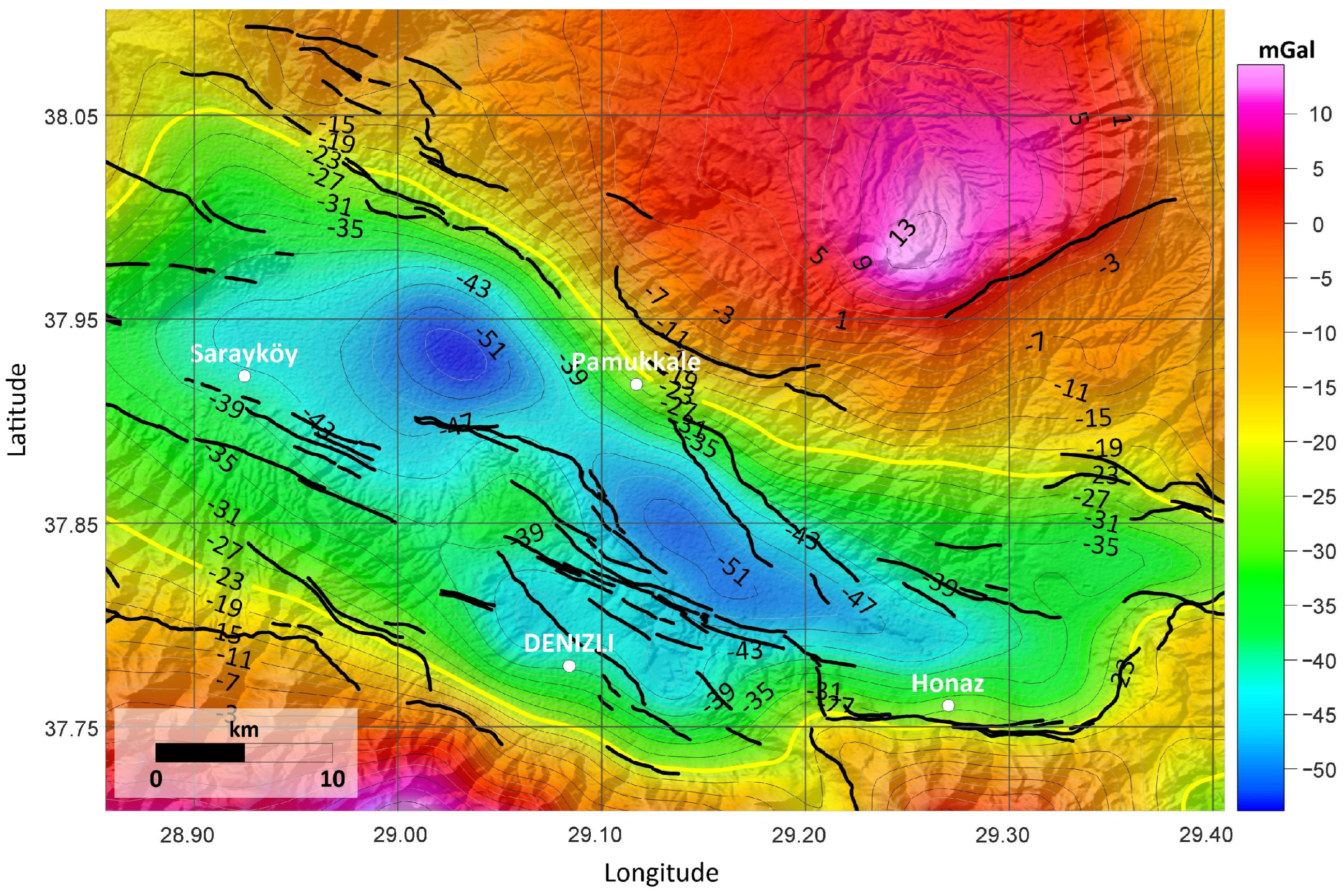
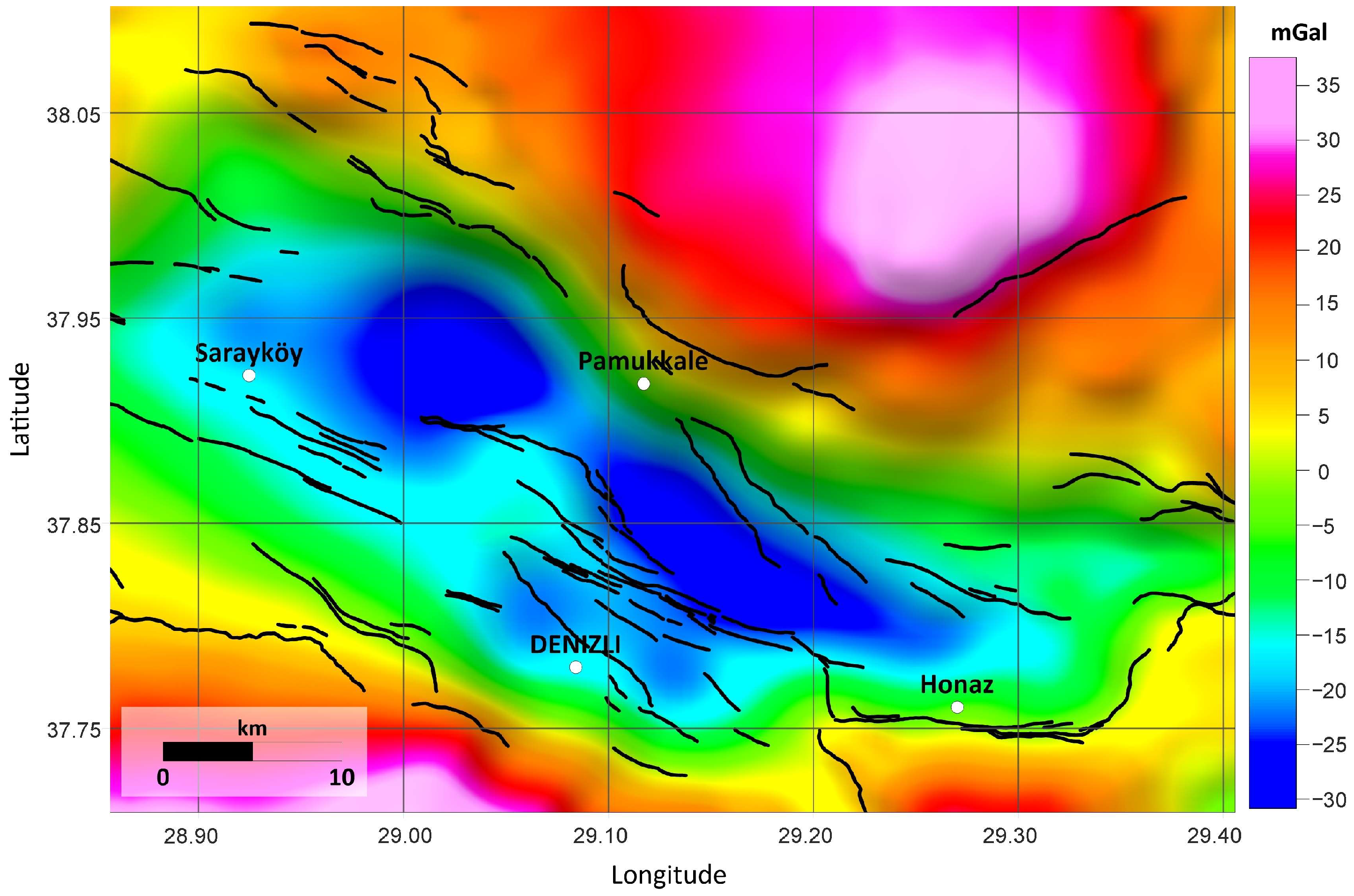
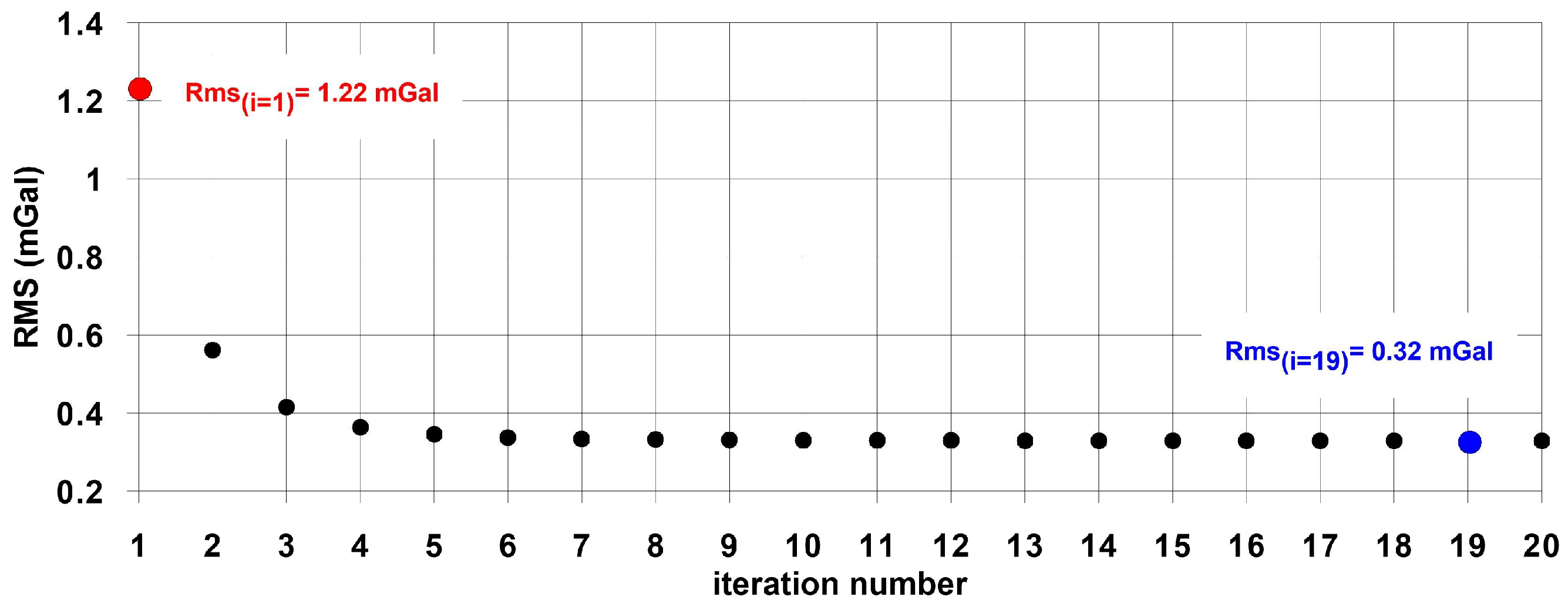
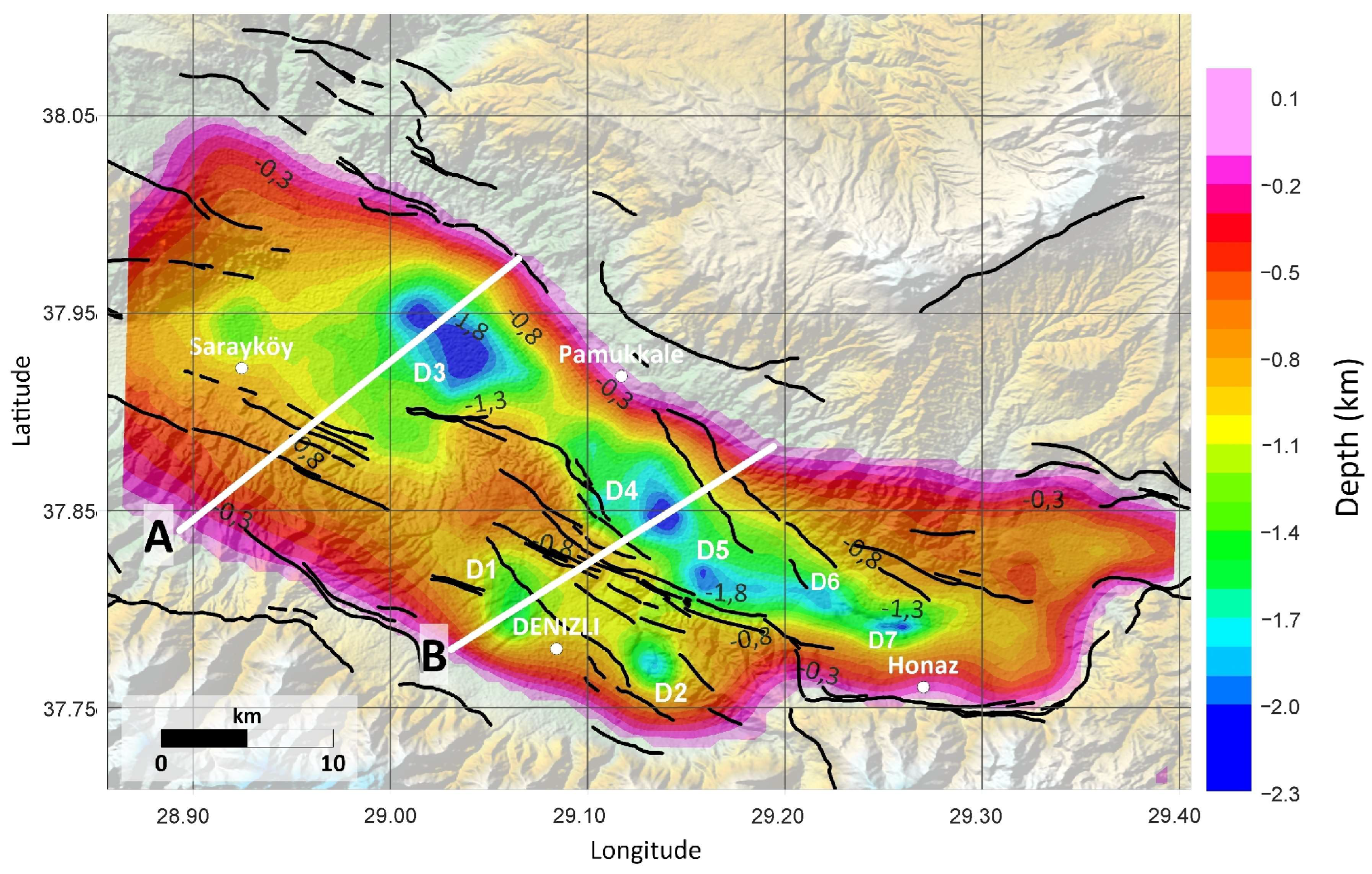
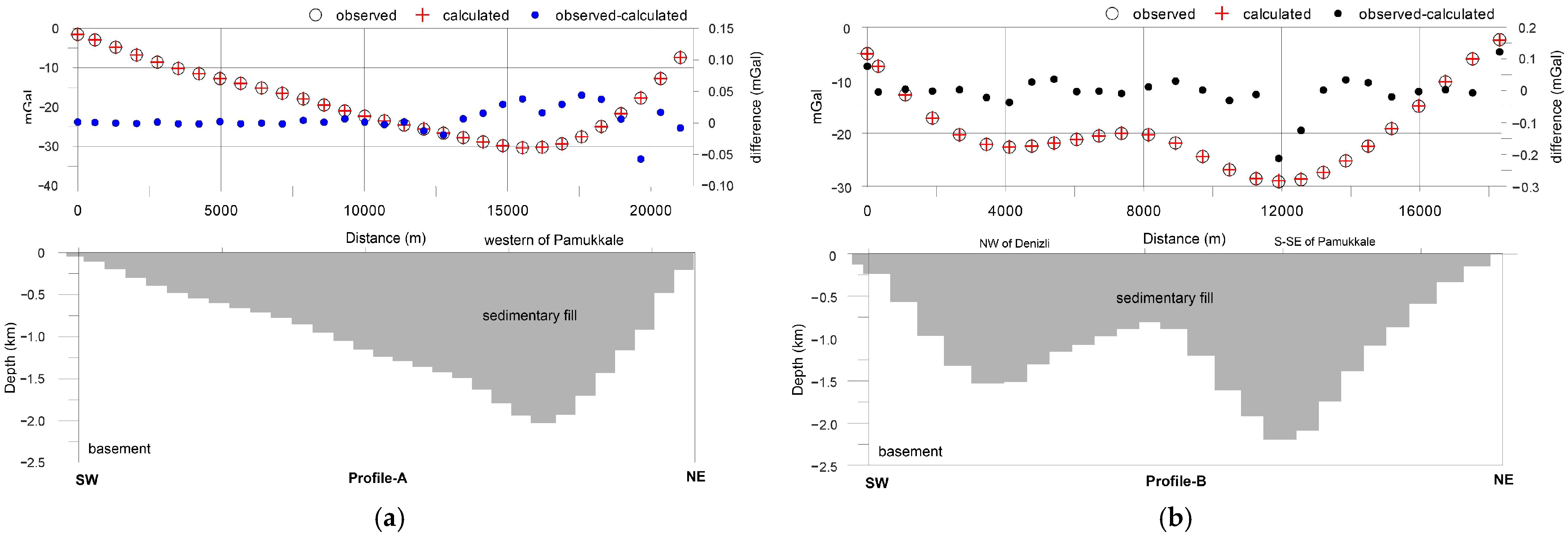
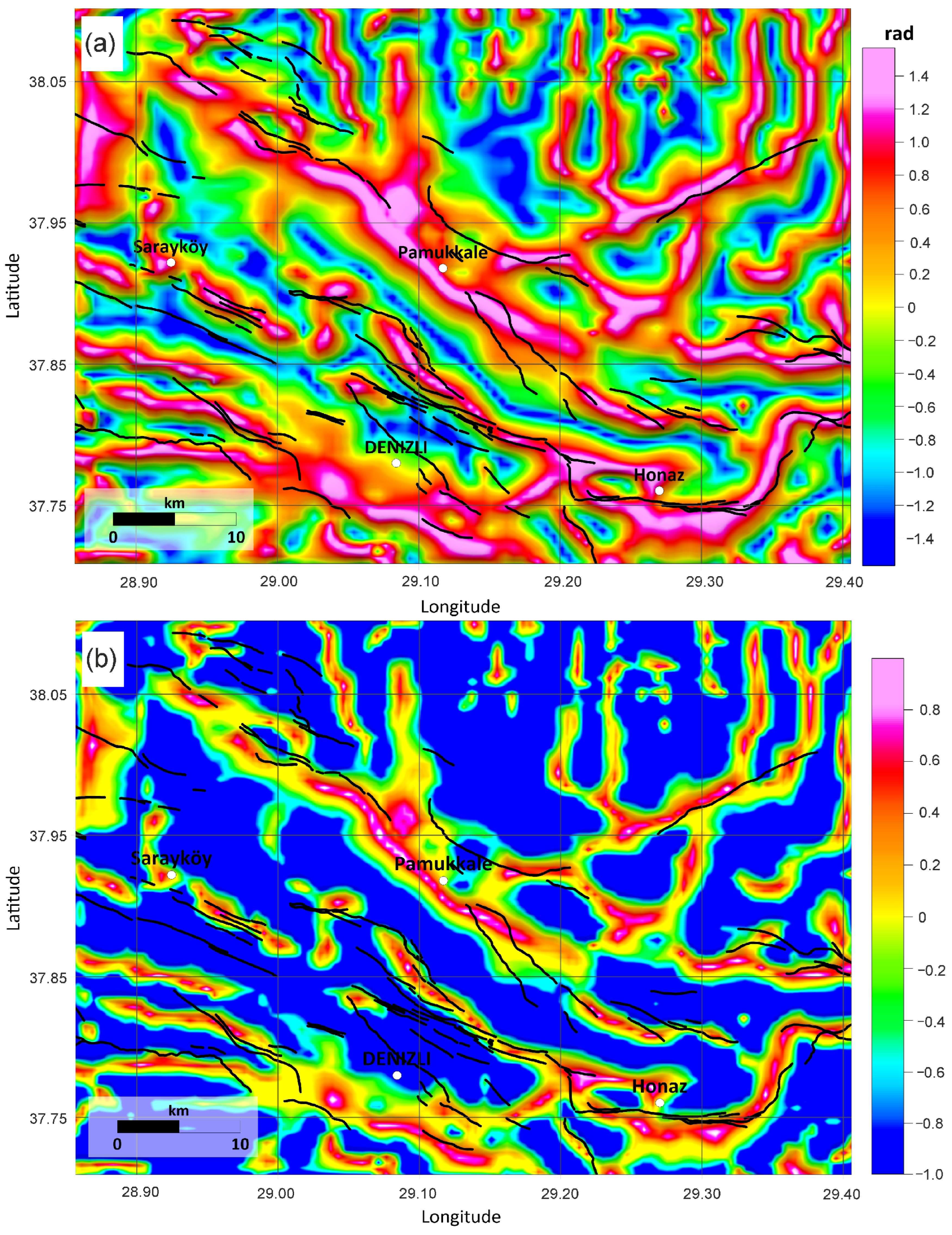
Disclaimer/Publisher’s Note: The statements, opinions and data contained in all publications are solely those of the individual author(s) and contributor(s) and not of MDPI and/or the editor(s). MDPI and/or the editor(s) disclaim responsibility for any injury to people or property resulting from any ideas, methods, instructions or products referred to in the content. |
© 2023 by the author. Licensee MDPI, Basel, Switzerland. This article is an open access article distributed under the terms and conditions of the Creative Commons Attribution (CC BY) license (https://creativecommons.org/licenses/by/4.0/).
Share and Cite
Altinoğlu, F.F. Mapping of the Structural Lineaments and Sedimentary Basement Relief Using Gravity Data to Guide Mineral Exploration in the Denizli Basin. Minerals 2023, 13, 1276. https://doi.org/10.3390/min13101276
Altinoğlu FF. Mapping of the Structural Lineaments and Sedimentary Basement Relief Using Gravity Data to Guide Mineral Exploration in the Denizli Basin. Minerals. 2023; 13(10):1276. https://doi.org/10.3390/min13101276
Chicago/Turabian StyleAltinoğlu, Fatma Figen. 2023. "Mapping of the Structural Lineaments and Sedimentary Basement Relief Using Gravity Data to Guide Mineral Exploration in the Denizli Basin" Minerals 13, no. 10: 1276. https://doi.org/10.3390/min13101276
APA StyleAltinoğlu, F. F. (2023). Mapping of the Structural Lineaments and Sedimentary Basement Relief Using Gravity Data to Guide Mineral Exploration in the Denizli Basin. Minerals, 13(10), 1276. https://doi.org/10.3390/min13101276





